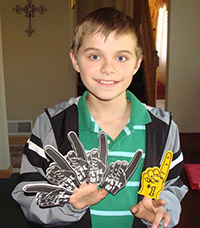Treatment Goals for Autism
 Once a child has been diagnosed with an autism spectrum disorder, a treatment program should begin immediately. Evidence over the last 15 years indicates that intensive early intervention for at least 2 years during the preschool years results in improved outcomes in most young children with autism. This is because the brain is most able to change when young.
Once a child has been diagnosed with an autism spectrum disorder, a treatment program should begin immediately. Evidence over the last 15 years indicates that intensive early intervention for at least 2 years during the preschool years results in improved outcomes in most young children with autism. This is because the brain is most able to change when young.
There is no single best treatment program for children with ASD. Effective treatment programs for ASD feature a combination of interventions, such as speech therapy, occupational therapy, and academic tutoring. These treatments should engage the child’s special interests to keep them involved in the tasks, and structure each task as a series of simple steps with regular positive reinforcement of behavior.
Parental involvement has been shown to be a major factor in treatment success. Parents should work with their child’s therapists to learn how to continue the therapeutic practices outside of the clinical setting. Many programs recognize that the child’s parents are their primary teachers, and these programs train parents to provide therapy at home.
Some Common Autism Interventions Include:
Speech Therapy
Speech therapy involves much more than than simply teaching a child to correctly pronounce words. In fact, a speech therapist working with an autistic child or adult may work on a wide range of skills including:
- Non-verbal communication. This may include teaching gestural communication, or training with PECS (picture exchange cards), electronic talking devices, and other non-verbal communication tools.
- Speech pragmatics. This includes practical training on the appropriate context for speech.
- Conversation skills. Speech therapists may work on back-and-forth exchange, sometimes known as “joint attention.”
- Concept skills. People with ASD often have difficulty understanding abstract ideas. Speech therapists may work on building concept skills.
Occupational Therapy
Since people with autism often lack some of the basic social and personal skills required for independent living, occupational therapists have developed techniques for working on all of these needs. For example:
- Provide interventions to help a child appropriately respond to information coming through the senses. Interventions may include swinging, brushing, playing in a ball pit, and other activities aimed at helping children with ASD better manage their body in space.
- Facilitate play activities that instruct as well as aid a child in interacting and communicating with others. For the OT specializing in autism, this can translate specifically into structured play therapies, such as Floortime, which were developed to build intellectual and emotional skills as well as physical skills.
- Devise strategies to help the individual transition from one setting to another, from one person to another, and from one life phase to another. For a child with autism, this may involve soothing strategies for managing transition from home to school; for adults with autism it may involve self-care and vocational skills.
- Develop adaptive techniques and strategies to get around apparent disabilities (for example, teaching typing when handwriting is too difficult, or selecting a weighted vest to decrease anxiety).
Behavioral Therapy
 Among the most effective behavioral therapies for working with children with autism are those that engage the child’s intrinsic motivation for learning. Intrinsic motivation uses the child’s innate interest in a subject to encourage the child to seek increasingly more knowledge in that area of study. A behavioral therapist using intrinsic motivators might utilize a child’s special interest in dinosaurs to create a social story that includes dinosaurs as the protagonists. In this way, learning becomes its own reward.
Among the most effective behavioral therapies for working with children with autism are those that engage the child’s intrinsic motivation for learning. Intrinsic motivation uses the child’s innate interest in a subject to encourage the child to seek increasingly more knowledge in that area of study. A behavioral therapist using intrinsic motivators might utilize a child’s special interest in dinosaurs to create a social story that includes dinosaurs as the protagonists. In this way, learning becomes its own reward.
Two frequently used play therapy interventions for children with ASD are DIR®/Floortime and RDI (Relationship Development Integration). These therapies help the child integrate their social, emotional, and intellectual capacities, rather than just focusing on skills and isolated behaviors. Both of these therapies allow the child’s special interests to encourage their learning, and engage the child in their physical environment and at their current level of emotional and cognitive development.
Applied Behavioral Analysis (ABA) is another therapy frequently used to treat people on the autism spectrum. ABA is a behavioral modification technique that claims to reduce inappropriate behaviors and increase communication and appropriate social behaviors. ABA often uses punishment and confrontational techniques to attempt to eradicate unwanted behaviors. Many psychologists and other therapists who work with people with autism use ABA, so this is likely to be the therapy that is available in most schools and clinical settings. ABA was developed by Dr. Ivar Lovaas nearly 50 years ago at the University of California, Los Angeles. It is an extension of the behavioral psychology research conducted by Dr. B. F. Skinner.
Social Skills Training
Social skills therapists are social workers, psychologists, occupational therapists, and speech/language therapists who specialize in working with autistic people. Drama therapists also teach social skills by scripting scenarios and/or improving and critiquing practice interactions.

In a school setting, social skills therapy may consist of group activities (usually games and conversation) with autistic children and their typically developing peers. Groups may be overseen by school psychologists or social workers, and may be held in the classroom, lunchroom, or playground. School social skills groups typically focus on game playing, sharing and conversation.
Out-of-school social skills groups are similar in style, but are paid for privately. Children are grouped by age and ability, and may make use of specific social skills curricula as developed by well-established practitioners of social skills therapy.
Effective social skills therapies provide people on the autism spectrum with the ability to converse, share, play and work with typical peers.
Dietary Interventions
Autism is often caused by a genetic predisposition with an environmental trigger. This trigger can sometimes be a sensitivity to specific foods that the person with ASD consumes on a regular basis. Common food sensitivities include gluten (wheat), casein (milk), corn, soy, nightshade vegetables (tomatoes and potatoes), as well as food dyes and food preservatives.
An IgG food sensitivity test (a blood test administered by a food allergist) is required to determine food sensitivities. The treatment for food sensitivities is to remove the foods that the individual reacts to, called a food exclusion diet. Many parents report that their children with ASD became better behaved, less moody, and less sensitive to sound, light, and touch when they adopted a food exclusion diet.
Providing Autism Support in Pennsylvania
412-781-4116 800-827-9385 support@AutismOfPA.org